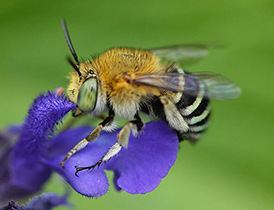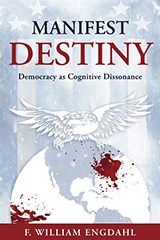
We’re Killing Off Our Vital Insects Too
By F. William Engdahl
2 March 2019
Image: Aussiegall - I Spy (by)) Credit: Louise Docker License: This file is licensed under the Creative Commons Attribution 2.0 Generic with some restrictions https://bit.ly/2Ts5587
Recent independent scientific studies indicate that we are threatening our vital global insect population, including of bees, with widespread extinction through massive deployment of agriculture pesticides. For most of us, insects such as flies or mosquitoes or wasps are nuisances to be avoided. Yet if the latest studies are any indication, we may be in danger of massive elimination of vital insects that maintain nature’s balance. The consequences to life on this planet are only now beginning to be seriously considered .
The first-ever worldwide study of declines of insect species and numbers has just been published by the journal, Biological Conservation. The conclusions are more than alarming. Among other conclusions the study found that over 40% of insect species are threatened with extinction.
The study found that habitat loss by the conversion to intensive agriculture is the main driver of the declines, as well as agrochemical pollutants such as glyphosate, neonicotinoids and other pesticides. The authors explain, “Here, we present a comprehensive review of 73 historical reports of insect declines from across the globe, and systematically assess the underlying drivers. Our work reveals dramatic rates of decline that may lead to the extinction of 40% of the world’s insect species over the next few decades.”
The study notes recent analyses that indicate that extensive usage of pesticides is the primary factor responsible for the decline of birds in grasslands and aquatic organisms such as fish or frogs in streams.
Among other things the study cites results of a 27-year study of insect populations in select German protected nature preserves that found a “shocking 76% decline in flying insect biomass at several of Germany’s protected areas…an average 2.8% loss in insect biomass per year in habitats subject to rather low levels of human disturbance. Worryingly, the study shows a steady declining trend over nearly three decades. A study in rain-forests of Puerto Rico has reported biomass losses between 98% and 78% for ground-foraging and canopy-dwelling arthropods over a 36-year period and parallel declines in birds, frogs and lizards at the same areas…”
Especially alarming were the declines in bee populations, especially bumblebees. Since 1980 they found that wild bee species in Britain declined by 52% and 67% in the Netherlands. In the United States, the country which pioneered intensive agribusiness and wide use of chemicals after World War II, they found that wild bees were declining in 23% of the country between 2008 and 2013, mainly in the Midwest, Great Plains and the Mississippi valley. These were the areas where grain production, particularly GMO corn for biofuel production using glyphosate and other chemicals was prevalent. Overall the USA went from a peak in 1947 of six million honey bee colonies, down to less than half or some 2.5 million colonies today. The decline began immediately as widespread agriculture use of the organochloride insecticide DDT was employed. Decline has continued unabated even after DDT was banned in 1972 in the United States as DDT was replaced by glyphosate-based alternatives and other chemical pesticides.
Irreversible decline?
What is poorly understood by the larger public is the essential role that insects play to the entire order of nature and species preservation. As the report notes, “shrews, moles, hedgehogs, anteaters, lizards, amphibians, most bats, many birds and fish feed on insects or depend on them for rearing their offspring. Even if some declining insects might be replaced with others, it is difficult to envision how a net drop in overall insect biomass could be countered.” The study concludes among other sobering points that “the application of herbicides to cropland has had more negative impacts on both terrestrial and aquatic plants and insect biodiversity than any other agronomic practice.” The far most widely used herbicide in the world today is glyphosate and Monsanto Roundup based on glyphosate.
Another recent study by the California Xerces Society for Invertebrate Conservation reported that California’s monarch butterfly population is at an all-time low. From the 1980s when monitoring began to 2017, some 97% of monarch butterflies had disappeared. Then from 2017 to today another 85% decline was registered. The scientists claim the intensive agriculture use of pesticides, herbicides is the main cause.
Scientists at the University of Texas have identified in experiments that glyphosate, the controversial herbicide in Monsanto Roundup, harms the microbiota needed by honeybees for growing and resisting pathogens. This, combined with earlier studies linking the group of neonicotinoid pesticides to bee deaths, suggest we need an urgent review of the toxins being widely applied to our agriculture crops. Notably, the world’s largest purveyor of both neonicotinoids and of glyphosate-based Roundup today is the merged giant Monsanto/Bayer.
These studies all are putting the focus on an aspect of agrochemical damage that until now has been largely ignored. But insects make up the structural and functional base of many of the world’s ecosystems. A world without birds and bees would be one of catastrophic damage to all life on our planet. Without insects, entire ecosystems collapse. Rather than solving world hunger as the agribusiness industry likes to claim, their promotion of select pesticides such as glyphosate threaten to destroy the food system. Nobody in their right mind would want to do that, would they?
F. William Engdahl is strategic risk consultant and lecturer, he holds a degree in politics from Princeton University and is a best-selling author on oil and geopolitics, exclusively for the online magazine “New Eastern Outlook”
